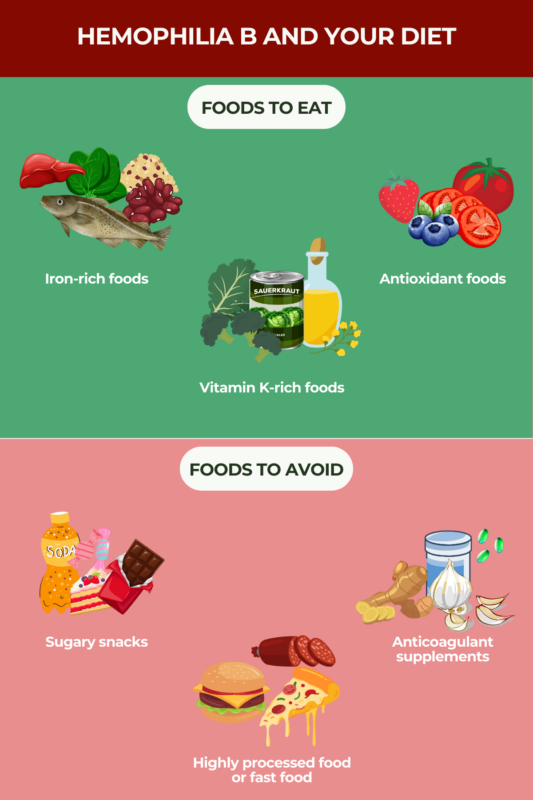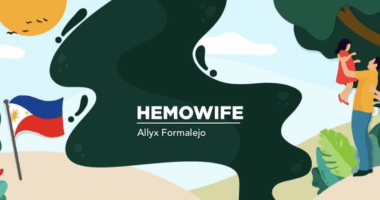The role of diet in managing hemophilia B
Last updated March 15, 2024, by Susie Strachan

While there isn’t any specific dietary strategy for managing hemophilia B, there are some key nutrition guidelines that can help improve the health of your body, and your blood.
A hemophilia B diet can provide nutrients that may help lower the risk of bleeding episodes and promote healing, such as iron for forming red blood cells and vitamin K for blood clotting, along with other important nutrients that can help with tissue repair and reducing inflammation.
To learn about the best dietary choices for your specific needs, consult a registered dietitian or nutritionist familiar with hemophilia B.
The importance of diet for people with hemophilia B
There are several goals for improving nutrition when it comes to living with hemophilia B. They are to:
- improve the blood’s ability to clot
- offer the main nutrients needed for red blood cell production
- maintain a healthy weight.
Hemophilia B is a genetic bleeding disorder caused by a deficiency or lack of clotting factor IX. Clotting factors are proteins in the blood that help stop bleeding when a blood vessel is injured. This can cause prolonged bleeding if injured or bruised.
The standard treatment for hemophilia B is factor replacement therapy to enhance the blood’s clotting ability.
During a bleeding episode, the impaired clotting process with hemophilia B leads to an even higher blood loss, potentially causing anemia, which is a shortage of red blood cells. Anemia may cause fatigue and weakness, particularly during physical activity.
Good nutrition can support your ability to make blood components, including red blood cells, through hematopoiesis, a process that primarily occurs in bone marrow. Nutrients such as iron and vitamin K, as well as plant- and animal-based sources of protein can help with this process.
Living with hemophilia B may make you cautious about exercising because of concern that it can increase the risk of bleeding into a joint and put you at a risk for obesity. Being overweight places additional strain on your joints.
Following a regular exercise and hemophilia B diet plan can improve your muscle strength, which in turn protects your joints and may help reduce the number of bleeding episodes. It also can give you more energy and make it easier to maintain a healthy weight.
Foods to eat
Incorporating specific nutrients into your diet and knowing what foods to eat is key to supporting red blood cell production, blood clotting, tissue repair, and reducing inflammation. Focus on iron-rich foods, vitamin K-rich foods, and essential nutrients like protein, omega-3 fatty acids, and antioxidants.
Always consult a healthcare provider before making changes to your diet.

Iron-rich foods
Iron is essential for producing hemoglobin, a protein in red blood cells that carries oxygen throughout your body.
Consuming iron-rich foods can help build up your red blood cells after a bleeding episode, reducing the risk of developing anemia. If you are a female with hemophilia B, you may also need more iron to replace blood lost when you have your menstrual period.
To increase your blood’s iron levels, eat naturally iron-rich foods from plant and animal sources.
Foods rich in iron include:
- liver
- lean red meat
- poultry
- fish
- leafy green vegetables like spinach and broccoli
- legumes
- tofu
- grains.
Pairing these iron-rich foods with sources of vitamin C, such as citrus, strawberries, and tomatoes, can increase iron absorption.
Vitamin K-rich foods
Vitamin K is needed for synthesizing clotting factors in the liver and helping the blood clotting process.
Vitamin K can be found in foods such as:
- leafy greens, including spinach, kale, and broccoli
- fermented foods such as sauerkraut
- vegetable oils such as canola, soybean, and olive oils.
Vitamin K is fat-soluble, so consuming these foods with a source of dietary fat can enhance its absorption. Healthy sources of fat include:
- avocados
- nuts such as almonds and walnuts
- chia seeds and flaxseeds
- salmon, mackerel, trout, and sardines
- extra virgin olive oil.
Other important nutrients
Various nutrients, including vitamins A, C, and E, as well as zinc, play essential roles in tissue repair and wound healing.
Protein also is essential for repairing and maintaining tissues, including muscles, ligaments, and blood vessels, and can be found in:
- lean meats
- dairy products
- leafy greens
- legumes.
Repairing damaged tissues will help you recover more quickly from bleeding episodes.
Try to include foods that have anti-inflammatory nutrients and antioxidants to reduce inflammation in the body and help support joint health and minimize the potential for bleeding into the joints.
Anti-inflammatory foods include:
- fatty fish
- spinach, kale, and other leafy greens
- whole grains including brown rice, quinoa, and oats
- berries such as blueberries, strawberries, and raspberries.
Antioxidants are found in:
- fruits such as berries and cherries
- vegetables such as broccoli and tomatoes.
Foods to limit or avoid
People with hemophilia B may want to limit or avoid certain foods, as some may cause an increased risk of bleeding and prolong bleeding episodes.
Others may promote weight gain, such as sugary snacks and processed foods, or alcohol, which may make you more likely to fall or injure yourself.
Be aware that certain supplements, including ginger, garlic, and ginkgo biloba, have anticoagulant properties, which means they have the potential to increase the risk of bleeding.
Certain types of foods can block iron absorption, such as:
- coffee
- tea
- egg yolks
- milk
- fiber
- soy protein.
Avoid eating these and iron-rich foods together.
Moderation in what you eat and consulting a healthcare professional before making adjustments to your diet is recommended.
Healthy meal plan
When planning your meals, try to choose whole foods, including fruits, vegetables, lean proteins, and whole grains. Avoid processed foods or fast food, which often contain unhealthy fats, high sodium, and additives.
Look for nutrient-dense foods that are rich in iron, vitamin K, and other essential nutrients that promote blood clotting and red blood cell production.
Your weekly meal plan should include three meals a day and some healthy snacks. Each meal should combine a protein, whole grains, vegetables, and fruit.
Practical tips
Cooking healthy, nutrient-rich meals is easier with some planning.
- Review the Dietary Guidelines for Americans and learn how to customize the foods you eat to add more iron, vitamin K, and other essential nutrients.
- Create your meal plan for the week and shop in advance so all your ingredients are on hand.
- Double your recipes and store the second meal in the fridge or freezer.
- Read the nutrition label on prepared foods. Avoid those with high amounts of sodium, sugar, unhealthy fats, and cholesterol.
Hemophilia News Today is strictly a news and information website about the disease. It does not provide medical advice, diagnosis or treatment. This content is not intended to be a substitute for professional medical advice, diagnosis, or treatment. Always seek the advice of your physician or other qualified health provider with any questions you may have regarding a medical condition. Never disregard professional medical advice or delay in seeking it because of something you have read on this website.
Recent Posts
Related articles






